
Pulsatilla alpina, the alpine pasqueflower or alpine anemone, is a species of flowering plant in the family Ranunculaceae, native to the mountain ranges of central and southern Europe, from central Spain to Croatia. It is an herbaceous perennial growing to 15–30 cm (6–12 in) tall by 20 cm (8 in) wide, and can be found at altitudes of 1,200–2,700 m (3,900–8,900 ft).
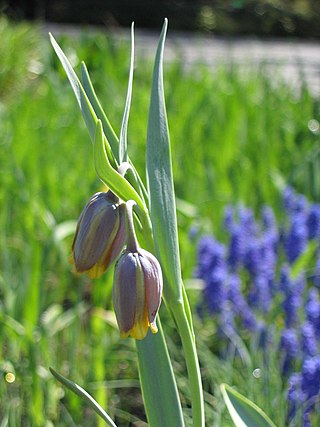
Fritillaria uva-vulpis, commonly called the fox's grape fritillary, is a bulbous perennial plant belonging to the genus Fritillaria and native to eastern Turkey, north-western Iraq and western Iran. They are mainly found in the wooded foothills of the Zagros, where they grow in damp meadows and cornfields between 900 and 1800 m above sea level.
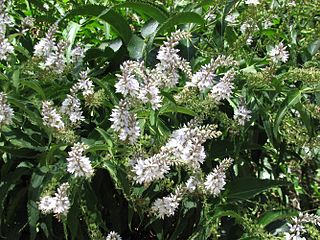
Veronica derwentiana, commonly known as Derwent speedwell, is a flowering plant species of the family Plantaginaceae, endemic to south-eastern Australia. It is a perennial with toothed leaves and white or pale blue flowers in terminal sprays in spring and summer.

Veronica albicans, synonym Hebe albicans, is a species of flowering plant in the family Plantaginaceae, native to New Zealand.

Veronica perfoliata, commonly known as digger's speedwell, is a common perennial herb found at higher altitudes in south-eastern Australia. It is a low-growing multi-stemmed plant rising from a woody rootstock. It has rounded blue-grey foliage and sprays of intense violet-blue flowers at the end of arching branches. It is occasionally cultivated as a garden plant.

Allium stipitatum, Persian shallot, is an Asian species of onion native to central and southwestern Asia.

Aquilegia pyrenaica, common name Pyrenean columbine, is a species of flowering plant in the family Ranunculaceae. It is endemic to the Pyrenees where it grows on grassland and in rocky places. It was first described in 1805 by Augustin Pyramus de Candolle who gave it the name Aquilegia pyrenaica.

Puschkinia scilloides, commonly known as striped squill or Lebanon squill, is a bulbous perennial, native to Western Asia and the Caucasus.
Iris afghanica is a plant species in the genus Iris, it is also in the subgenus Iris and in the section Regelia. It is a rhizomatous perennial, from Afghanistan, with thin bluish-green leaves and creamy yellow or white flowers, that are veined with purple-brown. It has yellow-green or purple beards. Although, in the wild, it can vary in colour and size. It is cultivated as an ornamental plant in temperate regions.
Iris heweri is a plant species in the genus Iris, it is also in the subgenus Iris and in the section Regelia. It is a rhizomatous perennial, from Afghanistan. It has tall, green curved leaves, tall slender stems and purple blue or violet-blue flowers, with white and purple or lilac beard. It is cultivated as an ornamental plant in temperate regions.
Iris goniocarpa is a plant species in the genus Iris, it is also in the subgenus of Iris and in the section Pseudoregelia. It is a rhizomatous perennial, from China, India, Burma and Bhutan. It has yellow green to dark green, long leaves, slender stem and, one flower between blue, lavender-blue, lilac, blue-violet or blue-purple. It is cultivated as an ornamental plant in temperate regions.
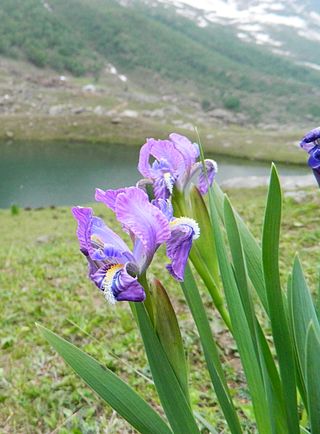
Iris hookeriana is a plant species in the genus Iris, it is also in the subgenus Iris and in the section Pseudoregelia. It is a rhizomatous perennial, from the Himalayan mountains of India and Pakistan. It has long pale green or yellow green leaves, long slender stem and fragrant blue, purple or lilac flowers, that are mottled with a darker colour. It is cultivated as an ornamental plant in temperate regions.
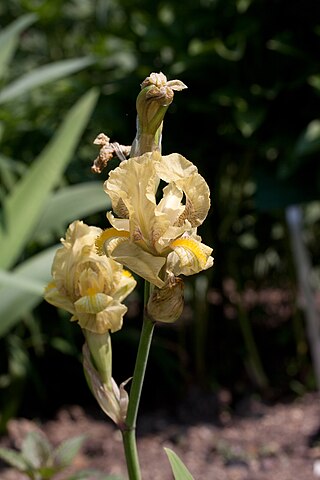
Iris imbricata is a species in the genus Iris, it is also in the subgenus Iris. It is a rhizomatous perennial, from the Caucasus mountains, within Iran, Armenia, Azerbaijan and Georgia. It has broad, sword-like, yellow green or light green leaves, slender stem with branches, inflated and overlapping green spathes, and 2–5 yellow, pale yellow or greenish yellow flowers.
Iris purpureobractea is a plant species in the genus Iris, it is also in the subgenus Iris. It is a rhizomatous perennial, from the cliffs and forest glades on the mountains of Turkey. It has straight or falcate shaped leaves, stem with several branches, the stem has purple spathes, it has up to 8 fragrant flowers, in various colours between yellow or blue. It is cultivated as an ornamental plant in temperate regions.
Iris schachtii is a plant species in the genus Iris, it is also in the subgenus Iris. It is a rhizomatous perennial, from central Anatolia, in Turkey. It has small, thin grey-green leaves, a short stem with 1–3 branches, which are normally, covered with a green leaf with purple staining. It has 2 or more fragrant flowers in late spring, which come in shades of yellow or purple, or violet and yellow,. It has a yellow or white with yellow-tips beard. It is cultivated as an ornamental plant in temperate regions, but prefers regions with dry, hot summers.

Iris acutiloba is a species in the genus Iris, it is also in the subgenus of Iris and section Oncocyclus. It is a rhizomatous perennial, from the mountains of the Caucasus and found in Turkey, Armenia, Azerbaijan, Turkmenistan, Dagestan in the North Caucasus, and Iran. It is a dwarf species, with narrow, falcate or curved leaves, it has one flower in spring or early summer, that comes in shades from cream, creamy white, whitish, pale brown, light grey, to pale violet. It is heavily veined or streaked and pointed, with 2 dark spots and brown, purple, dark purple, or black short beard. It is cultivated as an ornamental plant in temperate regions. There are two subspecies, Iris acutiloba subsp. lineolata and Iris acutiloba subsp. longitepala.

Iris iberica subsp. elegantissima is a subspecies in the genus Iris, subgenus Iris and section Oncocyclus. It is a subspecies of Iris iberica and is a rhizomatous perennial, from Armenia, Turkey and Iran. It has large, thin and falcate (sickle-shaped) leaves, slender stem with a single flower between April and May. It has a white, cream or pale yellow ground, which is covered in dark veining or speckling in violet, mauve, purple or brown shades. The larger standards are paler, normally white and less veined. The falls, have darker veining and a dark signal patch and brown or purple beard. It is commonly known as Iris elegantissima, especially in Europe and Russia. It is cultivated as an ornamental plant in temperate regions, but normally needs some protection during the winter period.
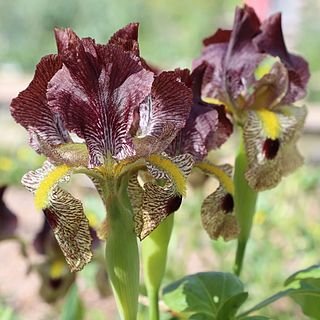
Iris paradoxa is a species of flowering plant native to western Asia. It has large upright petals and smaller lower petals, which is unique amongst most iris forms. They come in various shades from white, lavender, mauve, medium purple, violet, dark purple to black. It has a black or purplish black beard on the lower petals. It comes from the region of Transcaucasia, and is found in the countries of Iran, Turkey, Armenia and in Azerbaijan.

Iris sari is a species in the genus Iris, it is also in the subgenus Iris and in section Oncocyclus. It is from the rocky steppes and hills of Turkey. It has curved or straight leaves, cream, greenish or yellowish flowers which are variable and veined with crimson, purple-brown, reddish brown, reddish-purple or black. It has a dark maroon, rich crimson or brown signal patch and gold or yellow beard.

Iris sprengeri is a species in the genus Iris, it is also in the subgenus of Iris and in the Oncocyclus section. It is from the mountain slopes of Turkey. It has large flowers which are white, silver-white or cream, with purple-red or reddish-brown veining and a golden yellow beard and a dark purple or deep purple-brown signal patch.















